Tradition asserts that Tagaung is the cradle of Myanmar civilization. The founding of the first city by a Sakyan king who had migrated from India is reckoned hundreds of years before the birth of Buddha and the re-establishment of the capital by a second refugee prince is believed to have taken place about the 6th century B.C. The legend continues that after several centuries a royal brother of the king at Tagaung while chasing a wild boar, reached a place where Sri Ksetra was to be founded later and settled down as a hermit. In course of time, he met two young princes who, being blind since they were born, were drifted down the river on a raft and were miraculously cured by an ogress in the course of their journey. Learning that they were his nephews he married the elder prince to his adopted niece. There was a Pyu queen ruling in that country and as the hermit was venerated by the queen and her people he married her also to the elder prince and raised him, king. When their son Duttabaung came to the throne the city of Sri Ksetra was founded for him by Sakra.
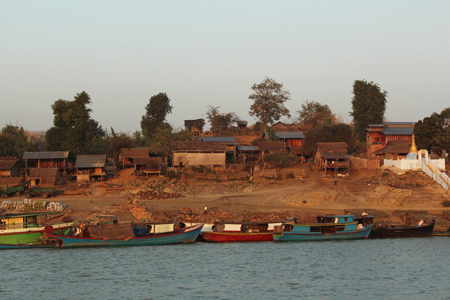
Perhaps this legend was fabricated by those who wanted to assert the glory and antiquity of the Myanmar ancestry. As a matter of fact, they appear to have adopted a parallel story culled from ancient Indian lore for no evidence antedating the Bagan period has yet been found at Tagaung.
This ancient site lies 127 miles above Mandalay on the left bank of the Ayeyarwady. The earliest mention of it as an outlying town occurs in a twelfth-century inscription from Bagan. A Myanmar inscription discovered at the site is dated 1354 A.C. But for the fort walls and traces of moats around the twin cities very few ancient ruins are visible. The northern city at the bend of the Ayeyarwady river is in the form of an oval narrowing towards the south and the adjacent southern city known as Upper Bagan is roughly rectangular. This latter name itself is suggestive of its contemporaneity, more or less, with the Myanmar capital, Bagan. Almost the whole area within the ancient wall is occupied by the modern town so there is not much left for prospective excavation. In the southern city are a few villages scattered in the northern sector. The Shwezigon, a large ruined pagoda, lies near the center of the enclosed site.
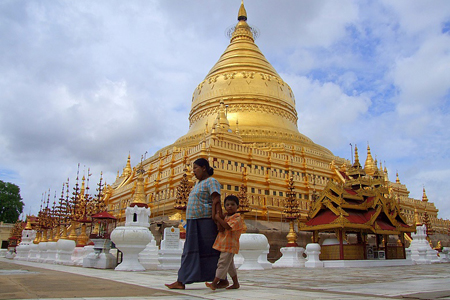
During earlier excavations, surface finds were made of clay votive tablets belonging to the Bagan period. The reported discovery by an archaeologist about a century ago of a Sanskrit inscription purporting to record the history of the site was later found to be untrue and has since been dismissed as a piece of merely unsubstantiated information.
Proper excavation of the site was done recently in the open seasons of 1967-68 and 1968-69. The extent of the two walled towns combined is far less than that of Halin. The maximum length of Tagaung is 800 yards and the maximum breadth 300 yards. The east wall of Upper Bagan measures 1,350 yards, the southern wall 770 yards, and the short northern wall 400 yards. The west wall has evidently been washed away by the river. Excavation in the northern town was confined to four sites on the walls. The digging at the south-western corner and cutting across the west wall reveal that the west wall which runs along the river bend was constructed after the original wall had disappeared by erosion. At each of these two points was exposed to the foundation of a square bastion. The thickness of the western wall is lesser than that on the south but the west bastion is larger than the corner projection.
In the southern town excavation of a mound on the east wall laid bare the gateway complex which is peculiar to this ancient site. The entrance passage flanked by an arm on either side takes a square turn northward by providing a screen which projects at right angles to the southern or left flank. The charred remains of a wooden gate and a stone socket on which the door was fixed were recovered at the interior extremity of the entrance passage. It was found that the gateway through the southern wall was also constructed in the same manner.
Substantial buildings were not found at the mounds excavated within this area. As in other fortified cities of old there is a square enclosure in the center of this southern fort. The limits of this area were verified by digging at the four comers, and the cutting across the east wall of this brick enclosure exposed an entrance with rounded comers. But no structure was traced in the center of this quadrangle. The Shwezigon pagoda lies between this inner enclosure and the eastern wall. Though it is believed to be of great antiquity only clay votive tablets datable to the Bagan period were discovered from the debris. The ruined structure was repaired in 1902 but it collapsed again after a few decades and is still under reconstruction by public donation.
Of a few more mounds excavated within the southern city three turned out to be habitation sites and two the remains of religious structures of brick and timber with tile roofing.
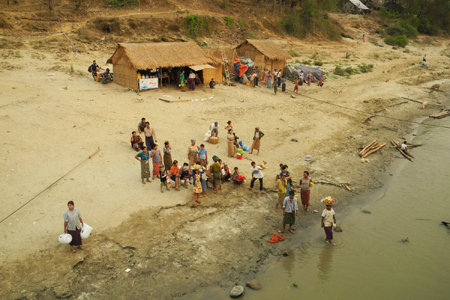
The excavations yielded many votive tablets of which two types are peculiar to Tagaung. The first is a small circular tablet like a clay lamp about 2l/2 inches in diameter containing only one figure of Buddha seated in the earth-touching attitude with overlapping legs. The second type of tablet is about 7 inches high, containing one central figure of seated Buddha flanked by two standing Buddhas. The arch over the central figure is topped by a pyramidal spire resembling the Bodhgaya temple in India. The space beside the spire is filled with small stupas. At the bottom of the tablet are two lines of the Buddhist creed in Nagari characters stamped in bold relief, which may be dated to the 10th-11th century. The third type, which is similar to those found at Bagan, has the shape of a pointed oval. Enclosed by a prominent rim is a seated Buddha on a lotus throne in an arch surmounted by a “Bodhgay” spire and flanked by pagodas of varying sizes. The Buddha is in the earth-touching attitude. The Buddhist stanza in Nagari is stamped in relief below the lotus seat. This type found in large numbers at Bagan belongs to Anawrahta’s reign. The fourth type of tablet is also high rimmed but has a straight base, convex sides, and a pointed tip. It contains a Buddha seated in the earth-touching attitude within an arched niche as in other specimens. The legend, in Nagari script, below the throne gives the title of a king which probably belongs to Sawlu, Anaw rahta’s successor. This type does not occur in Bagan but was found in a few riverine sites between Mandalay and Katha. Chance finds were also reported of several tablets of early Bagan type with Anawrahta’s seal in Pali incised on the reverse.
An invaluable piece of sculpture discovered during the excavations is a dolomite slab, 4 inches high, bearing in bold relief the eight principal scenes in Buddha’s life. The left portion and the top are broken off, leaving intact the central figure in a slightly damaged condition and scenes from three episodes on the right. Apart from this piece four fragments from a similar slab were also recovered. They belong to the same type of which fine specimens were found at Bagan.
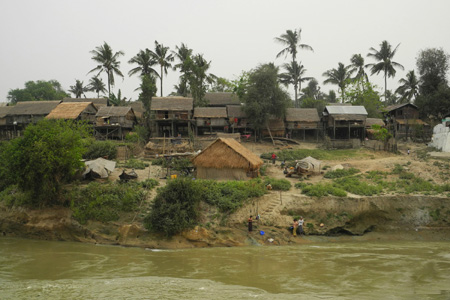
Though each of the two towns is comparable in size to the walled citadel of Bagan there are fewer religious structures of contemporary age than at the latter site. Consequently, large Buddha images are entirely absent. Only fragments of small images were recovered by excavation. One is a clay head of Buddha, 6 inches high. It is finely modeled like the stone images of Bagan exhibiting the influence of the Pala art of the 9th-12th century. The left ear and the tip of the conical topknot are damaged. The hair is marked by rows of beads. The half-closed eyes assume a down-cast appearance. The thin eye-brows slant upwards. The nose is prominent and the low lip of the smallmouth is thick and slightly drooping. The chin is rather pointed. The right ear-lobe does not touch the shoulder. The neck seems to belong originally. With the exception of the absence of a small dot between the eyebrows representing the urna mark this Buddha head displays the same character as that of the dolomite figure mentioned above. Such types are representative of the images in stone and bronze of the early Bagan period. The second fragment, also in well-baked clay of reddish color, comprised the lower part of a seated Buddha in the earth-touching posture and a portion of the lotus- throne. The right hand having well-proportioned fingers is indicative of early Bagan art.
A small circular clay seal, 11/2 inches in diameter, bearing three short lines, partially weathered, was recovered from the excavation site at the south-west corner of the city wall of Tagaung. The writing, stamped in relief, is in square characters as in the early inscriptions of Bagan. It reads ‘Seal of Thingyi Nga K.ye Thin’, by which we can make out that the owner belonged to the upper-middle-class society of Bagan.
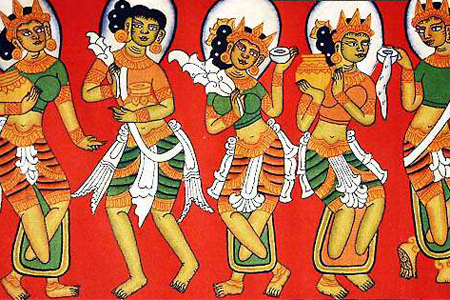
A considerable number of potsherds were excavated but all these represent the Bagan types of storage jars, goblets, bowls, lamps and long-necked vases with straight spouts. Clay beads or spindle-whorls and pieces of iron nails are also among the small finds recovered.
The results of the excavation evidently testify that Tagaung rose to be an important fortified city during Anawrahta’s reign. There must have existed a small settlement or a small town in that place itself long before the Bagan period but there are no hopeful signs of obtaining convincing proof to the effect that its antiquity could be pushed back to the early centuries of the Christian era.
